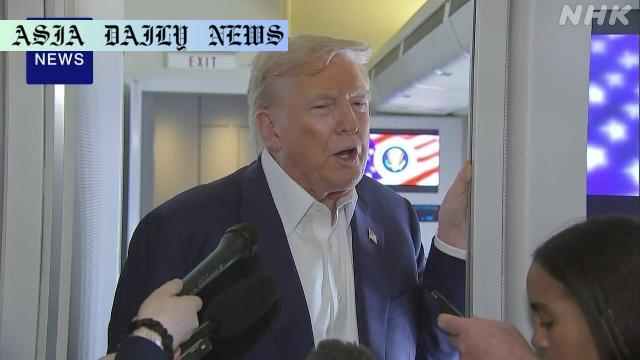Ceasefire: US President Donald Trump moves the Russia-Ukraine ceasefire deadline forward, pressuring Russia with sanctions and tariffs.

Introduction: The New Ceasefire Deadline
President Donald Trump’s firm stance on the Russia-Ukraine war has taken another definitive turn as he announced a newly advanced deadline for a ceasefire agreement between the two nations. Previously set for early September, the deadline has now been dramatically shifted to August 8—just ten days from the time of his announcement. The decision reflects Trump’s growing impatience with what he perceives as the lack of progress in halting the ongoing conflict. The bold move is paired with a direct threat of imposing severe sanctions and tariffs aimed at pressuring Russia into compliance.
Trump’s Persistent Pressure Campaign
Trump’s approach toward Russia has shifted considerably over recent months, with this latest development revealing a clear escalation in his rhetoric. The US president has threatened to expand current sanctions on Russia while also targeting its trading partners with high tariffs if no progress toward a ceasefire is made. In his statement, Trump acknowledged challenges, expressing skepticism about whether his actions would influence Russian President Vladimir Putin’s stance. However, he remains resolute, stating that measures like domestic oil production increases could mitigate potential economic fallout caused by these sanctions or tariffs.
Kremlin’s Calculated Response
While Trump’s ultimatum made waves internationally, the Kremlin’s reaction was far less dramatic. Dmitry Peskov, the spokesperson for the Russian government, confirmed their knowledge of Trump’s comments but refrained from providing any significant acknowledgment or movement toward engaging with the proposed ceasefire agreement. Instead, Russia doubled down on its stance of continuing “special military operations” in Ukraine, raising questions about the feasibility of the newly imposed deadline.
Assessing the Broader Impact
With tensions running high between the US and Russia, this unilateral advancement of the ceasefire deadline has implications far beyond the scope of the ongoing war. The mere proposal of additional sanctions and tariffs raises concerns not only for the two primary nations but for global markets as well. Oil prices, for instance, are closely tied to stability in Eastern Europe, and any disruptions could have cascading effects worldwide. Nevertheless, Trump has dismissed these concerns, touting America’s self-reliance in energy production as a shield against potential market volatility. This sense of confidence underscores the administration’s belief in swift action as a means of influencing international behavior.
The Challenges Ahead
While the Trump administration’s strategy appears determined and impactful on paper, the pathway to a ceasefire agreement remains fraught with complexities. Historically, sanctions and economic pressures have produced mixed results when employed as tools of diplomacy. Furthermore, with Russia maintaining a defiant posture under President Putin’s leadership, the likelihood of meeting the August 8 deadline appears slim. What remains unclear is how far the US is willing to go in enforcing its proposed trade measures if Russia continues its operations in Ukraine unabated. Meanwhile, Ukraine, bearing the brunt of this geopolitical standoff, continues to face humanitarian and infrastructural challenges as the war prolongs.
Conclusion: A Pivotal Moment
In setting this new ceasefire deadline, Trump has sent a clear message to both allies and adversaries that the tolerance for prolonged conflict is waning within the US government. However, the feasibility of achieving such an outcome within the established timeline will depend not only on Russia’s response but also on the broader international community’s willingness to engage diplomatically. Regardless of the deadline’s outcome, this pivotal moment underscores the urgency of finding a sustainable solution to the war in Ukraine and highlights the complexities involved in crafting international policies to ensure peace.
Commentary
A Bold but Risky Move
President Donald Trump’s decision to accelerate the Russia-Ukraine ceasefire timeline to August 8 underscores his administration’s desire to exert maximum pressure on Moscow. However, this approach carries significant risks, primarily because it operates under the assumption that sanctions and tariffs alone are sufficient to force a change in Russia’s behavior. Historically, economic sanctions have been successful in drawing international attention to conflict zones, but their effectiveness in compelling an immediate cessation of hostilities remains debatable. Given President Putin’s resilience and strategic tendencies, it is unlikely that Moscow will bend to US pressure without securing concessions of its own.
The Global Ripple Effects
The potential impact of Trump’s ultimatum extends far beyond the corridors of diplomacy. Energy markets, international trade, and even the stability of alliances could feel the strain of this new deadline. For example, the addition of tariffs or sanctions could lead to disruptions in key global supply chains, particularly for nations heavily reliant on Russian resources. Moreover, allies of the US may find themselves in precarious positions, caught between their commitments to supporting Ukraine and maintaining trade relationships with Russia. Such complexities highlight the need for cautious, yet resolute diplomacy during these times of heightened tension.
A Critical Test of Leadership
At its core, Trump’s ultimatum represents a critical test of his administration’s ability to navigate the dangerous waters of international diplomacy. On the one hand, the move demonstrates a readiness to take decisive action; on the other, it risks alienating key players whose support is crucial for ensuring long-term stability. In confronting this balance, it becomes evident that achieving a sustainable ceasefire will require not only rhetoric and economic coercion but also the careful alignment of global interests to create an environment conducive to peace negotiations. Whether or not such outcomes are realized by August 8 remains to be seen, but one thing is certain—the stakes could not be higher for all parties involved.


